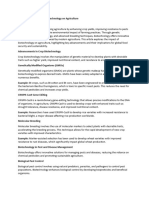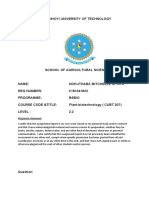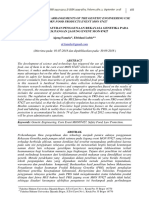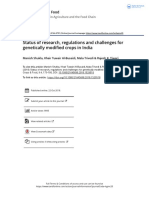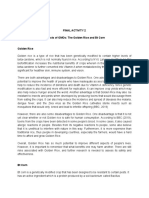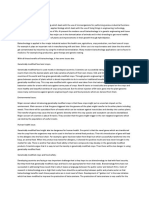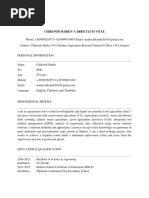0 ratings0% found this document useful (0 votes)
8 viewsDela Torre - Critique Paper 6
Dela Torre - Critique Paper 6
Uploaded by
Wynona Mae Dela Torre1) Biotechnology plays an important role in food production and processing by improving microbial cultures for food fermentation, producing enzymes and food ingredients through microbial fermentation, and developing genetically modified crops.
2) The Philippines relies heavily on agricultural imports and could benefit economically from utilizing genetically modified crops, which could increase food supply and profits for farmers.
3) Golden Rice was developed to address widespread vitamin A deficiencies in the Philippines and could help combat malnutrition through genetic engineering to produce beta-carotene in rice.
Copyright:
© All Rights Reserved
Available Formats
Download as PDF, TXT or read online from Scribd
Dela Torre - Critique Paper 6
Dela Torre - Critique Paper 6
Uploaded by
Wynona Mae Dela Torre0 ratings0% found this document useful (0 votes)
8 views2 pages1) Biotechnology plays an important role in food production and processing by improving microbial cultures for food fermentation, producing enzymes and food ingredients through microbial fermentation, and developing genetically modified crops.
2) The Philippines relies heavily on agricultural imports and could benefit economically from utilizing genetically modified crops, which could increase food supply and profits for farmers.
3) Golden Rice was developed to address widespread vitamin A deficiencies in the Philippines and could help combat malnutrition through genetic engineering to produce beta-carotene in rice.
Original Description:
critique paper example
Original Title
Dela Torre - critique paper 6
Copyright
© © All Rights Reserved
Available Formats
PDF, TXT or read online from Scribd
Share this document
Did you find this document useful?
Is this content inappropriate?
1) Biotechnology plays an important role in food production and processing by improving microbial cultures for food fermentation, producing enzymes and food ingredients through microbial fermentation, and developing genetically modified crops.
2) The Philippines relies heavily on agricultural imports and could benefit economically from utilizing genetically modified crops, which could increase food supply and profits for farmers.
3) Golden Rice was developed to address widespread vitamin A deficiencies in the Philippines and could help combat malnutrition through genetic engineering to produce beta-carotene in rice.
Copyright:
© All Rights Reserved
Available Formats
Download as PDF, TXT or read online from Scribd
Download as pdf or txt
0 ratings0% found this document useful (0 votes)
8 views2 pagesDela Torre - Critique Paper 6
Dela Torre - Critique Paper 6
Uploaded by
Wynona Mae Dela Torre1) Biotechnology plays an important role in food production and processing by improving microbial cultures for food fermentation, producing enzymes and food ingredients through microbial fermentation, and developing genetically modified crops.
2) The Philippines relies heavily on agricultural imports and could benefit economically from utilizing genetically modified crops, which could increase food supply and profits for farmers.
3) Golden Rice was developed to address widespread vitamin A deficiencies in the Philippines and could help combat malnutrition through genetic engineering to produce beta-carotene in rice.
Copyright:
© All Rights Reserved
Available Formats
Download as PDF, TXT or read online from Scribd
Download as pdf or txt
You are on page 1of 2
Dela Torre, Wynona Mae G.
May 18, 2023
BS PetEng 1B1 GE-STS
STS Prof. Lea M. Camangeg
Critique Paper 6: (The Role of Biotechnology in Food Production and Processing by
Balarbe, M. M., Mohammed, S. S. D., and Idris, S.)
Synopsis
The article is entitled “The Role of Biotechnology in Food Production and Processing”
by Balarbe et al., written in the Department of Microbiology, Faculty of Science, Kaduna State
University, Kaduna, Nigeria, and was published on January 15, 2018. The paper contains
information about the application of biotechnology in food processing, such as food
fermentation, the production of enzymes, the production of food ingredients, the use of
biotechnology in diagnostics for food testing, the role of biotechnology in food production the
safety of food produced with biotechnology as well as the risks and benefits of biotechnology
in food production.
According to the article, Biotechnology is any technological application that uses
biological systems, living organisms or derivatives thereof to make or modify products or
processes for specific use (as cited in UN Convention on Biological Diversity, 2002). One of
its applications is in food fermentation wherein biotechnology is being utilized to improve
microbial cultures through traditional and molecular approaches. Next, biotechnology is used
in the commercial production of enzymes from bacteria and fungi that were only possible on
plant and animal sources before. Furthermore, biotechnology also plays an important role in
the production of food ingredients through microbial fermentation which produces amino acid
supplements, flavor enhancers, and vitamins added to breakfast cereals. It also improved
starter cultures, specifically GM starter cultures which are necessary for bread, beer, yogurt,
cheese, and salami production in such a way that these are being produced faster and
increase the number of yields. Moreover, GM foods are the most notable contribution of
biotechnology in food science. These bioengineered foods are pest-resistant, herbicide-
tolerant, cold-tolerant, and drought-tolerant, have a higher level of nutrition, and can be used
in pharmaceuticals. Some examples of GM foods are Biotechnology Soybean, Biotechnology
Maize, Biotechnology Rice, Biotechnology Tomato, Biotechnology Cotton and etc. Most of
these products are herbicide tolerant and insect-tolerant which helps to increase production.
Biotechnology can also be used in Diagnostics for Food Testing through Microarrays which
are used to detect pathogens, pesticides, and toxins and offer considerable potential for
facilitating process control, the control of fermentation processes, and monitoring the quality
and safety of raw materials (Balarbe et al., as cited in Barallon et al.,1996). Aside from the
application of biotechnology in food, it also gives a significant contribution to food production.
As crops become resistant to pests and extreme weather, production will increase, harvesting
will be improved, and storage will last longer. As a result, these products will be sold at lower
prices which benefits consumers. It can also benefit farmers as product loss is less likely to
happen because of these advances. In addition, foods produced with biotechnology
processes ensure the safety of people as strong shreds of evidence show that there is no
known food safety concern related to consuming
food produced through biotechnology. In fact, a number of food and health organizations
support this kind of food. Of all the benefits shown in biotechnology, of course, there are
downsides. One of them is the unexpected allergic reaction that may arise in consumers
because the genes could be transferred to other crops in which they are not intended to go
in. Furthermore, GM crops are relatively high in cost that farmers may find it hard to bring
back their capital.
Critical point
Biotechnology is undeniably helpful and relevant to the fast-growing modern world of
today. Food, which is one of the essential commodities in our lives benefits from the advances
of biotechnology. According to Philippine Statistics Authority, the 2021 total expenditures for
agricultural imports reached PhP 773.61 billion and recorded an annual increase of 24.0
percent from the previous year’s record of PhP 623.98 billion. Whereas the total export in the
same year summed up to PhP 334.24 billion. Meaning, our government is spending more
than making a profit on agricultural products. This will also burden our local farmers since the
more supply we have, the lower its price, which will make our farmers have a hard time
regaining their capital and making a profit. So, utilizing GM crops here in the country is helpful
to our farmers and our economy as it will help to increase the supply of crops, which will make
our government not rely mostly on imports to meet the demand of our society. In the same
way, farmers will benefit also since they will have more profit. Moreover, micronutrient
deficiencies in the Philippines are widespread. Besides iron and iodine deficiencies, Vitamin
A deficiency is considered a major health problem, with prevalence rates exceeding the WHO
cut-off points. Because of this Golden Rice was invented to provide a new intervention to
combat VAD. It was developed through genetic engineering to produce beta-carotene in its
endosperm, giving it the distinct yellow color that affords it the name Golden Rice
(Zimmermann & Qaim, 2004). Surprisingly, Golden Rice was developed by the Department
of Agriculture-Philippine Rice Research Institute (DA-PhilRice) in partnership with the
International Rice Research Institute (IRRI) to contain additional levels of beta-carotene,
which the body converts into vitamin A (IRRI, 2021). Workings of biotechnology on food
science is indeed a huge relief not just in our economy but also in the health of humanity.
Relevance to Society
Advancement in food science through biotechnology brought solutions to food supply
challenges we have in the country. In fact, the government supports agro-biotechnology as
a method to improve Philippine agricultural productivity (Richmond, 2006). If we continue to
utilize GM foods or crops, we will attain food security, thus will give welfare to humanity as
well.
References
1. PHILIPPINE STATISTICS AUTHORITY (PSA). The Agricultural Indicators System (AIS). Quezon City: Philippine
Statistics Authority. September 2022. electronic version.
https://psa.gov.ph/sites/default/files/FO%205_AIS%20Agri%20Exports%20and%20Imports%202022%20ao%203
0Sept_signed.pdf
2. Zimmermann, R., & Qaim, M. (2004). Potential health benefits of Golden Rice: a Philippine case
study. Food Policy, 29(2), 147-168.
3. International Rice Research Institute. Last modified July 22, 2021. https://www.irri.org/news-and-
events/news/philippines-becomes-first-country-approve-nutrient-enriched-golden-rice
4. Christina L. Richmond, Comment, Genetically Modified Crops in the Philippines: Can Existing
Biosafety Regulations Adequately Protect the Environment?, 15 Pac. Rim L & Pol'y J. 569 (2006).
Available at: https://digitalcommons.law.uw.edu/wilj/vol15/iss2/8
You might also like
- How To Sharpen Your KnifeDocument67 pagesHow To Sharpen Your KnifeDiego BouNo ratings yet
- Lesson 2 Government Laws, Policies, Plans and Projects Pertaining To Science and TechnologyDocument24 pagesLesson 2 Government Laws, Policies, Plans and Projects Pertaining To Science and TechnologyDesiree Thea Tapar100% (1)
- The Benefits and Ethical Issues Behind Using Genetically Modified Organisms in AgricultureDocument5 pagesThe Benefits and Ethical Issues Behind Using Genetically Modified Organisms in Agriculturebrijmohansingh401124No ratings yet
- Technologies and Their Role in Enhancing Food SecurityDocument5 pagesTechnologies and Their Role in Enhancing Food Security33844No ratings yet
- Term Paper On LaboratoryDocument5 pagesTerm Paper On LaboratoryJoyce TalasanNo ratings yet
- Probiotics Media: Significance, Challenges, and Future Perspective - A Mini ReviewDocument13 pagesProbiotics Media: Significance, Challenges, and Future Perspective - A Mini Review15041168No ratings yet
- Argumentative Essay Research PaperDocument5 pagesArgumentative Essay Research PaperJadNo ratings yet
- Biology Project 2023-24Document13 pagesBiology Project 2023-24Yasir HussainNo ratings yet
- Activity For BiotechDocument3 pagesActivity For BiotechRhobie Shayne BenogsodanNo ratings yet
- The Article dis-WPS OfficeDocument7 pagesThe Article dis-WPS Officegeorginho kingsNo ratings yet
- Biotechnology SeminarDocument32 pagesBiotechnology Seminaryanla6044No ratings yet
- Genetically Modified Foods and Social ConcernsDocument8 pagesGenetically Modified Foods and Social ConcernsLeika GonzalesNo ratings yet
- Science and Policy For Modern BiotechnologyDocument22 pagesScience and Policy For Modern BiotechnologyEjigayehu DesalegnNo ratings yet
- Report On BiotechnologyDocument10 pagesReport On BiotechnologyPrayash SinghNo ratings yet
- Term Paper ExampleDocument12 pagesTerm Paper Examplekatherineobias4No ratings yet
- Article 4Document3 pagesArticle 4Shankar KulkarniNo ratings yet
- Gseugte 3 EryuiiDocument6 pagesGseugte 3 EryuiiBMontepio, Christian LloydNo ratings yet
- Biotech ProjectDocument11 pagesBiotech Projectapi-239353816No ratings yet
- Group 3Document22 pagesGroup 3Marilyn F. Agbayani 10 FaithNo ratings yet
- BIOTECHNOLOGY2Document21 pagesBIOTECHNOLOGY2mydreamat666No ratings yet
- Gmo EssayDocument5 pagesGmo Essayapi-604802402No ratings yet
- Nokuthaba Plant Biotech Assignment 1Document5 pagesNokuthaba Plant Biotech Assignment 1Nokuthaba SiyafaNo ratings yet
- Efektifitas Pengaturan Penggunaan Rekayasa Genetika Pada Produk Pangan Jagung Event Mon 87427 Ajeng Famela, Efridani LubisDocument13 pagesEfektifitas Pengaturan Penggunaan Rekayasa Genetika Pada Produk Pangan Jagung Event Mon 87427 Ajeng Famela, Efridani LubisMuhammad YusupNo ratings yet
- APPLICATIONS OF BIOTECHNOLOGY IN AGRICULTUREDocument15 pagesAPPLICATIONS OF BIOTECHNOLOGY IN AGRICULTUREespuidolNo ratings yet
- Stas111 - The Biodiversity and Healthy SocietyDocument3 pagesStas111 - The Biodiversity and Healthy Societykdcolarines0578qcNo ratings yet
- Research PG2Document15 pagesResearch PG2Jerome ManriqueNo ratings yet
- MollyDocument2 pagesMollyMelissaNo ratings yet
- Status of Research Regulations and Challenges For Genetically Modified Crops in IndiaDocument17 pagesStatus of Research Regulations and Challenges For Genetically Modified Crops in Indiamonty singhNo ratings yet
- Trends in BiotechnologyDocument3 pagesTrends in BiotechnologysuzshruthiNo ratings yet
- Assignment... Bio TechnologyDocument22 pagesAssignment... Bio TechnologyMuhammad Adeel JavedNo ratings yet
- Plant Biotechnology: Attainment of Food SecurityDocument8 pagesPlant Biotechnology: Attainment of Food SecurityayushNo ratings yet
- A Mini-review on the Role of Bacteriophages in Food SafetyDocument8 pagesA Mini-review on the Role of Bacteriophages in Food SafetyNgọc hân BếNo ratings yet
- Biology Mock EssayDocument9 pagesBiology Mock Essayliameric2No ratings yet
- 600 WordprojectDocument1 page600 Wordprojectapi-318894104No ratings yet
- Case Study (2)Document34 pagesCase Study (2)nguyen hangNo ratings yet
- Eassy GM FoodDocument5 pagesEassy GM FoodSH LimNo ratings yet
- CaraigKristine STAS FinalActivity2Document2 pagesCaraigKristine STAS FinalActivity2Charles GaliciaNo ratings yet
- BTEC MFO. - Lumictin, Rica Mae SDocument6 pagesBTEC MFO. - Lumictin, Rica Mae SRICA MAE LUMICTINNo ratings yet
- BIOTECHNOLOGY IN FOOD PRODUCTION GMOS AND BEYONDDocument34 pagesBIOTECHNOLOGY IN FOOD PRODUCTION GMOS AND BEYONDyanla6044No ratings yet
- Biotechnology ArticleDocument3 pagesBiotechnology Articledanica jade patacsilNo ratings yet
- Food Biotech Q ADocument2 pagesFood Biotech Q ADr.Neelam JainNo ratings yet
- Recent Advances in Food Biotechnology ResearchDocument36 pagesRecent Advances in Food Biotechnology ResearchFabian GomezNo ratings yet
- Study Guide 12 2023Document7 pagesStudy Guide 12 2023Jun Jun JunNo ratings yet
- 5 Paragraph Essay: Genetically Modified FoodDocument5 pages5 Paragraph Essay: Genetically Modified FoodAwais AliNo ratings yet
- Problems and Prospects of Genetically Modified Organisms in Agricultural ProductionDocument36 pagesProblems and Prospects of Genetically Modified Organisms in Agricultural ProductionMajestyNo ratings yet
- Agricultural BiotechnologyDocument38 pagesAgricultural Biotechnologyapi-310253984100% (2)
- Plant BiotechnologyDocument3 pagesPlant BiotechnologyLittleagleNo ratings yet
- A Review of Inorganic Fertilizer On Genetically Modified Organisms-1Document34 pagesA Review of Inorganic Fertilizer On Genetically Modified Organisms-1Andrew JamesNo ratings yet
- Bio Project Prakhar Edited BibliographyDocument21 pagesBio Project Prakhar Edited Bibliographyprakharbutani6No ratings yet
- Unveiling the Secrets: The Truth About Genetically Modified FoodsFrom EverandUnveiling the Secrets: The Truth About Genetically Modified FoodsNo ratings yet
- Pablo Borbon Main II Batangas City: Republic of The Philippines Batangas State UniversityDocument5 pagesPablo Borbon Main II Batangas City: Republic of The Philippines Batangas State UniversityChichiri NomiNo ratings yet
- Importance of Biotechnology in AgricultureDocument4 pagesImportance of Biotechnology in AgricultureVinu Nair100% (4)
- Plant Biotechnology For Food Security and BioeconomyDocument5 pagesPlant Biotechnology For Food Security and BioeconomyHanna KaruniaNo ratings yet
- Issues in BiotechnologyDocument5 pagesIssues in Biotechnologymaricar baculoNo ratings yet
- GM Food 750 Hunger, Malnutrition, and The Rising Population-1Document6 pagesGM Food 750 Hunger, Malnutrition, and The Rising Population-1Lam ChanNo ratings yet
- GMOs Argumentative EssayDocument3 pagesGMOs Argumentative EssayLoc NguyenNo ratings yet
- S.L.V. Plant Technologies Privated LTDDocument69 pagesS.L.V. Plant Technologies Privated LTDPrashanth PBNo ratings yet
- Biotech GmoDocument5 pagesBiotech GmoHappy SeptemberNo ratings yet
- Give The Meaning of The FollowingDocument2 pagesGive The Meaning of The FollowingAdrian ArazaNo ratings yet
- Awareness of Grade 9 Students in Genetically Modified Organisms (GMO) Food Products A Survey StudyDocument5 pagesAwareness of Grade 9 Students in Genetically Modified Organisms (GMO) Food Products A Survey StudyInternational Journal of Innovative Science and Research TechnologyNo ratings yet
- A Study of Food Marketing PracticesDocument115 pagesA Study of Food Marketing PracticesMohit AggarwalNo ratings yet
- Prairie Moon Nursery 2021 Cultural Guide InsertDocument17 pagesPrairie Moon Nursery 2021 Cultural Guide InsertjhNo ratings yet
- Chikondi Marko. CVDocument4 pagesChikondi Marko. CVBright CementNo ratings yet
- 373 ArticleText 2195 1 10 20220417esubalewet - Al2022Document12 pages373 ArticleText 2195 1 10 20220417esubalewet - Al2022siraj likiNo ratings yet
- Amal International School: Grade 7 HistoryDocument6 pagesAmal International School: Grade 7 HistoryJehan100% (1)
- Full Download Managing Wine Quality: Volume 1: Viticulture and Wine Quality (Woodhead Publishing Series in Food Science, Technology and Nutrition) 2nd Edition Andrew G. Reynolds (Editor) PDF DOCXDocument40 pagesFull Download Managing Wine Quality: Volume 1: Viticulture and Wine Quality (Woodhead Publishing Series in Food Science, Technology and Nutrition) 2nd Edition Andrew G. Reynolds (Editor) PDF DOCXtriasitanoup100% (4)
- Ordinance On HapagDocument4 pagesOrdinance On Hapagfreimark50% (2)
- Commercial GeographyDocument2 pagesCommercial GeographyAhsan IqbalNo ratings yet
- Multipurpose Tree Species and Bio Remediation Through MPTs of SoilDocument19 pagesMultipurpose Tree Species and Bio Remediation Through MPTs of Soild4rkrakeshNo ratings yet
- Raz Lj41 Argentina CLR DsDocument10 pagesRaz Lj41 Argentina CLR Dsywan258No ratings yet
- Indian Economic Development NCERT Class XIDocument207 pagesIndian Economic Development NCERT Class XIguru1241987babu100% (1)
- Cultural Achievements of PreDocument6 pagesCultural Achievements of PreRoi Vincent VillaraizNo ratings yet
- Income Generating ProjectProposalDocument4 pagesIncome Generating ProjectProposalOliver C Silvano100% (2)
- Preferred Paddy Varieties: Directorate of Agriculture Chepauk, ChennaiDocument16 pagesPreferred Paddy Varieties: Directorate of Agriculture Chepauk, ChennaiMurali daranNo ratings yet
- Lecture 1 - Farm Power EngineeringDocument76 pagesLecture 1 - Farm Power EngineeringHeleana Faye BundocNo ratings yet
- Swathi - 73rd and 74th Constitutional Amendments - HSPDocument7 pagesSwathi - 73rd and 74th Constitutional Amendments - HSPswathikaNo ratings yet
- Tuta Absoluta - MonographDocument55 pagesTuta Absoluta - MonographBiljana AtanasovaNo ratings yet
- Agricola - A Plain and Simple GuideDocument4 pagesAgricola - A Plain and Simple Guidedeltaxgaming101No ratings yet
- Engineering Properties of Agricultural and Food ProductsDocument47 pagesEngineering Properties of Agricultural and Food ProductsBilly Agustin100% (1)
- Classification of PlantsDocument57 pagesClassification of PlantsELLA EATANo ratings yet
- Burhan PurDocument31 pagesBurhan Purar.viplavibiyaniNo ratings yet
- HM GuidelineDocument27 pagesHM GuidelineHimadri BabuNo ratings yet
- Oyster Farming in The PhilippinesDocument13 pagesOyster Farming in The PhilippinesElizabeth B DiestroNo ratings yet
- JNR CATALOG 20241008-2Document18 pagesJNR CATALOG 20241008-2Mahé BizeulNo ratings yet
- Tamil NaduDocument49 pagesTamil NaduPhoenixNo ratings yet
- Gramona Gessami EngDocument3 pagesGramona Gessami EngMVSA餐飲部No ratings yet
- Research Proposal PDFDocument29 pagesResearch Proposal PDFZele Kaemba100% (2)
- IBALEDocument8 pagesIBALEIbale, Arjay D.No ratings yet















